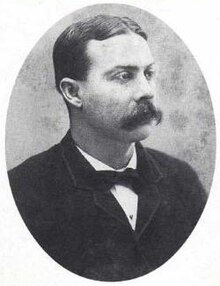George E. Goodfellow
| George E. Goodfellow | |
|---|---|

Dr. George E. Goodfellow
|
|
| Born |
December 23, 1855 Downieville, California |
| Died | December 7, 1910 (aged 54) Los Angeles, California |
| Occupation | Physician |
| Known for | First civilian trauma surgeon; authority on gunshot wounds; first surgeon to perform a laparotomy to treat gunshot wounds; first to perform a perineal prostatectomy; published first surface rupture map of an earthquake in North America; first known use of spinal anesthesia; pioneered the use of sterile techniques in treating gunshot wounds. |
| Spouse(s) | Katherine Colt, Mary Elizabeth |
| Children | Edith, George M. |
Dr. George Emory Goodfellow (December 23, 1855 – December 7, 1910) was a physician and naturalist in the American Old West who developed a reputation as the United States' foremost expert in treating bullet wounds. As a physician in Tombstone, Arizona Territory, he treated many gunshot wounds to both lawmen and outlaws. He performed the first recorded laparotomy for treating an abdominal gunshot wound and was the first surgeon to perform a perineal prostatectomy to remove an enlarged prostate. He pioneered the use of spinal anesthesia and sterile techniques in treating gunshot wounds and is regarded as the first civilian trauma surgeon.
Goodfellow was a pugnacious, "brilliant and versatile" physician with wide-ranging interests. During his life he not only practiced medicine; he studied earthquakes and published the first surface rupture map of an earthquake in North America, interviewed Geronimo, conducted research into the venom of Gila monsters, and played a role in brokering a peace settlement in the Spanish–American War. He was also a skilled boxer and in his first year at the United States Naval Academy, he became the Academy boxing champion, but was dismissed for kicking and beating the first African-American to attend the institution. In 1889, he got into a fight with another man and stabbed him, but was found to have acted in self-defense.
Goodfellow treated Virgil Earp and Morgan Earp after they were wounded in the Gunfight at the O.K. Corral. His testimony later helped absolve the Earps and Doc Holliday of murder charges when they shot and killed three outlaw Cowboys and supported their contention that they acted lawfully. He treated Virgil again when he was maimed in an ambush and rushed to Morgan's side when he was mortally wounded by an assassin.
He left Tombstone in 1889 and established a successful practice in Tucson before moving to San Francisco in 1899 and opened a medical office there. He lost his practice and all of his personal belongings in the 1906 San Francisco Earthquake and returned to the Southwest where he became the Chief Surgeon for the Southern Pacific Railroad in Mexico. He fell ill during 1910 and died later that year in Los Angeles.
...
Wikipedia
